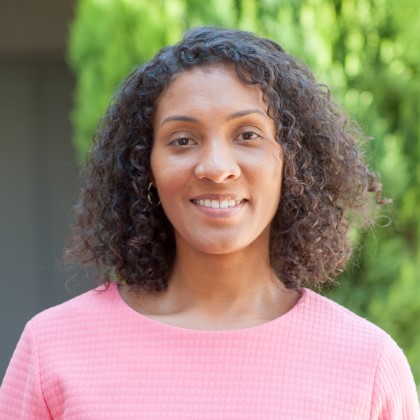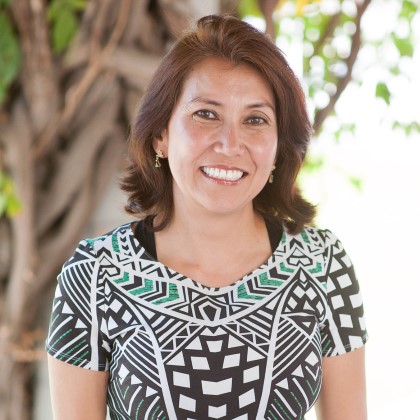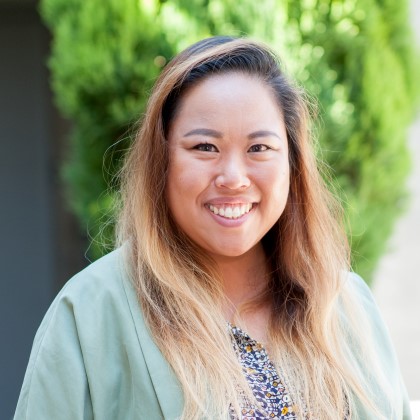Digital Equity in Teacher Education
Professional Bios:
 Nicol Howard
Nicol Howard
My work is motivated by the encouragement and support I received throughout my own academic journey. I believe that successful education is achieved when students are provided some form of encouragement, support, and/or quality academic direction. In my teaching, I strive to be supportive and available for my own students. Through my research, I examine the potential impact of encouragement and support on achievement for underrepresented K12 students, especially when faced with stereotypes and misinformed perceptions related to their academic ability.
Nirmla Flores
 What drives me as an educator is the idea that life is one long learning curve. In my association with life, I have come to the realization that earning a degree does not necessarily translate to getting an education. Rather, the more a person knows, the more s/he spirals into a perpetual state of ignorance, and serendipitously, yearns to satisfy an unrelenting hunger for more knowledge. Hence, as an educator of aspiring teachers, I believe that each student should have the opportunity to satisfy his/her hunger for knowledge and reach his/her fullest potential relative to the resources available and the students’ personal skills and abilities. Needless to say, I aspire to motivate teacher candidates to establish a nurturing relationship with each student, ensuring that s/he feels valued as an individual. One way to achieve this is to encourage all educational stakeholders (i.e. parents, teachers, community, businesses, etc.) to get involved and actively participate in the child’s physical, emotional, mental, spiritual, and academic development through meaningful interaction and student engagement.
What drives me as an educator is the idea that life is one long learning curve. In my association with life, I have come to the realization that earning a degree does not necessarily translate to getting an education. Rather, the more a person knows, the more s/he spirals into a perpetual state of ignorance, and serendipitously, yearns to satisfy an unrelenting hunger for more knowledge. Hence, as an educator of aspiring teachers, I believe that each student should have the opportunity to satisfy his/her hunger for knowledge and reach his/her fullest potential relative to the resources available and the students’ personal skills and abilities. Needless to say, I aspire to motivate teacher candidates to establish a nurturing relationship with each student, ensuring that s/he feels valued as an individual. One way to achieve this is to encourage all educational stakeholders (i.e. parents, teachers, community, businesses, etc.) to get involved and actively participate in the child’s physical, emotional, mental, spiritual, and academic development through meaningful interaction and student engagement.
Stephanie Quan
 I am driven by the belief that our education system is more than just a structure for learning facts. Our schools were made to set a foundation for how to successfully function and use one's personal interests and strengths in his or her specific callings in the real world. Teachers are the heart of this structure and the opportunities I have been granted to guide students are what keep me motivated to continue my work as an educator. As a mathematics educator, I am committed to improving the learning experiences of students. Many of them come to their classes with negative attitudes toward the content and possess low self-esteem in their skills as a mathematics student. Mathematics classrooms are in need of teachers who will help build up students’ confidence in mathematics so they do not fear taking risks and immersing themselves in their learning. As more students continue to develop angst toward the subject with the many changes going on in education, it is important to me to advocate for students and support teachers in providing quality mathematics learning that is engaging, inclusive, and relevant.
I am driven by the belief that our education system is more than just a structure for learning facts. Our schools were made to set a foundation for how to successfully function and use one's personal interests and strengths in his or her specific callings in the real world. Teachers are the heart of this structure and the opportunities I have been granted to guide students are what keep me motivated to continue my work as an educator. As a mathematics educator, I am committed to improving the learning experiences of students. Many of them come to their classes with negative attitudes toward the content and possess low self-esteem in their skills as a mathematics student. Mathematics classrooms are in need of teachers who will help build up students’ confidence in mathematics so they do not fear taking risks and immersing themselves in their learning. As more students continue to develop angst toward the subject with the many changes going on in education, it is important to me to advocate for students and support teachers in providing quality mathematics learning that is engaging, inclusive, and relevant.
Project Summary:
We aspire to pass on a reliable strategy for evaluating technology tools that will allow faculty and students (future teachers) to engage in their classrooms with ease and confidence, knowing that the technology tools they are using are meaningful to all students. Additionally, our goal is to help teachers minimize their time scouting through a plethora of technology tools offered that may or may not serve the needs of their students. Our technology proposal centers around the idea of achieving digital equity across classes by comparatively analyzing technology programs and strategies used by our district partners in order to make recommendations for teaching and learning in our MALT courses. We will focus on the following areas: Productivity (e.g. lesson planning tools, classroom management platforms), Collaboration (e.g. group project platforms, information sharing tools), Communication (e.g. conferencing tools, social media, web-based newsletters), Evaluation (e.g. online rubrics, evaluation tools, assessment platforms), Assistive and Adaptive (e.g. sensory devices, listening systems), Personalized/Blended Learning (e.g. self-paced platforms, station rotation model, 1:1 device use), and Physical Computing and Virtual Learning (e.g. Makerspaces, A/R, V/R). Although we will inevitably make specific technology app and tool recommendations, our goal is to focus on a timeless approach given the ever-evolving nature of the field of edtech. To that end, we will: 1) Evaluate the range in tech-use across current courses taught by part-time and full-time faculty in the MALT program through an internal survey (January 2018), 2) Determine what faculty and students need to know, understand, and do through an examination of the newly revised Teacher Performance Expectations (TPEs), ISTE Standards for Teachers and Students, and the Office of Educational Technology’s National Education Technology Plan (NETP) (Jan. - Feb. 2018), 3) Examine the technology programs at various partner districts to categorize low, med, and high levels of tech-use to inform how to best prepare our teacher candidates for the range of technology programs implemented across potential hiring districts (Feb. - Mar. 2018), 4) Identify preliminary recommendations based upon data from the internal faculty survey and district site observations, ensuring alignment with the ISTE standards, NETP, and a technology modified Bloom’s Taxonomy (April 2018), 5) Pilot preliminary recommendations for the focus areas (Productivity, Collaboration, Communication, Evaluation, Assistive and Adaptive Tech, and Personalized/Blended Learning) in four of the courses taught by the faculty on this grant (April - May 2018), 6) Determine final recommendations in order to design and launch a resource site to support our faculty, students, and potentially the larger field of teacher education (May 2018), and 7) Demo lessons and offer additional faculty support through video tutorials (May - June 2018).

 Nicol Howard
Nicol Howard What drives me as an educator is the idea that life is one long learning curve. In my association with life, I have come to the realization that earning a degree does not necessarily translate to getting an education. Rather, the more a person knows, the more s/he spirals into a perpetual state of ignorance, and serendipitously, yearns to satisfy an unrelenting hunger for more knowledge. Hence, as an educator of aspiring teachers, I believe that each student should have the opportunity to satisfy his/her hunger for knowledge and reach his/her fullest potential relative to the resources available and the students’ personal skills and abilities. Needless to say, I aspire to motivate teacher candidates to establish a nurturing relationship with each student, ensuring that s/he feels valued as an individual. One way to achieve this is to encourage all educational stakeholders (i.e. parents, teachers, community, businesses, etc.) to get involved and actively participate in the child’s physical, emotional, mental, spiritual, and academic development through meaningful interaction and student engagement.
What drives me as an educator is the idea that life is one long learning curve. In my association with life, I have come to the realization that earning a degree does not necessarily translate to getting an education. Rather, the more a person knows, the more s/he spirals into a perpetual state of ignorance, and serendipitously, yearns to satisfy an unrelenting hunger for more knowledge. Hence, as an educator of aspiring teachers, I believe that each student should have the opportunity to satisfy his/her hunger for knowledge and reach his/her fullest potential relative to the resources available and the students’ personal skills and abilities. Needless to say, I aspire to motivate teacher candidates to establish a nurturing relationship with each student, ensuring that s/he feels valued as an individual. One way to achieve this is to encourage all educational stakeholders (i.e. parents, teachers, community, businesses, etc.) to get involved and actively participate in the child’s physical, emotional, mental, spiritual, and academic development through meaningful interaction and student engagement. I am driven by the belief that our education system is more than just a structure for learning facts. Our schools were made to set a foundation for how to successfully function and use one's personal interests and strengths in his or her specific callings in the real world. Teachers are the heart of this structure and the opportunities I have been granted to guide students are what keep me motivated to continue my work as an educator. As a mathematics educator, I am committed to improving the learning experiences of students. Many of them come to their classes with negative attitudes toward the content and possess low self-esteem in their skills as a mathematics student. Mathematics classrooms are in need of teachers who will help build up students’ confidence in mathematics so they do not fear taking risks and immersing themselves in their learning. As more students continue to develop angst toward the subject with the many changes going on in education, it is important to me to advocate for students and support teachers in providing quality mathematics learning that is engaging, inclusive, and relevant.
I am driven by the belief that our education system is more than just a structure for learning facts. Our schools were made to set a foundation for how to successfully function and use one's personal interests and strengths in his or her specific callings in the real world. Teachers are the heart of this structure and the opportunities I have been granted to guide students are what keep me motivated to continue my work as an educator. As a mathematics educator, I am committed to improving the learning experiences of students. Many of them come to their classes with negative attitudes toward the content and possess low self-esteem in their skills as a mathematics student. Mathematics classrooms are in need of teachers who will help build up students’ confidence in mathematics so they do not fear taking risks and immersing themselves in their learning. As more students continue to develop angst toward the subject with the many changes going on in education, it is important to me to advocate for students and support teachers in providing quality mathematics learning that is engaging, inclusive, and relevant.